Astronomy:Sun Radio Interferometer Space Experiment
From HandWiki
Short description: Orbiting radio telescope
The Sun Radio Interferometer Space Experiment (SunRISE), is a set of CubeSats designed to study solar activity by acting as an aperture synthesis radio telescope.[1] It is intended to monitor giant solar particle storms.[2]
The satellites will occupy a supersynchronous geosynchronous Earth orbit.[3]
The participants in the experiment include JPL, the University of Colorado Boulder and the University of Michigan.[1][3][4] It is due to be launched in 2024.
Status
As of November 2023[update], the six satellites have been built and are going into storage to await their Vulcan Centaur launch vehicle.[5]
References
- ↑ 1.0 1.1 "SunRISE" (in en-US). https://www.jpl.nasa.gov/missions/sun-radio-interferometer-space-experiment.
- ↑ Potter, Sean (2020-03-30). "NASA Selects Mission to Study Causes of Giant Solar Particle Storms". http://www.nasa.gov/press-release/nasa-selects-mission-to-study-causes-of-giant-solar-particle-storms.
- ↑ 3.0 3.1 "Sun Radio Interferometer Space Experiment (SunRISE)" (in en). 2019-07-18. https://www.colorado.edu/ness/projects/sun-radio-interferometer-space-experiment-sunrise.
- ↑ "SunRISE Ground Radio Lab – Home for SunRISE for US high schools". https://sunrise.umich.edu/.
- ↑ "NASA's 6-Pack of Mini-Satellites Ready for Their Moment in the Sun". JPL. NASA. 30 November 2023. https://www.jpl.nasa.gov/news/nasas-6-pack-of-mini-satellites-ready-for-their-moment-in-the-sun.
 |

